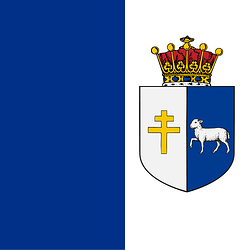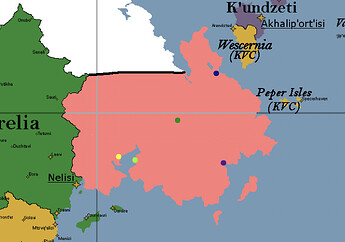Flag:
Nation Name (long): The Kingdom of Corvenia
Nation Name (short): Corvenia
Population: 45 Million
Total GDP: 950 Billion
GDP per Capita: $21,111
Currency: Corvenian Dollar
Demonym: Corvenian
Language: Corvenic and English
Species: Human’s
Religion: Orthodox Corvenism
Capital: Sanctyra
Largest City: Valmorra
Government Type: Unitary Hierocratic Absolute Monarchy
Leader(s): Patriarch Samuel
Legislature: The Council of High Prelates
Two-Letter Code: CO
Three-Letter Code: COV
*TLD: .cor
*Currency Code: cvd
Motto: Per Divinum Regnamus (By the Divine, We Rule)
National Anthem: Canticle of Corvenia
National Animal(s): Lamb / Sheep
National Plant: Oak Tree
Historical Summary:
The area now known as Corvenia has a long history of habitation by various groups and cultures. These groups spoke different languages, had distinct customs, and, importantly, embraced differing religious beliefs. The closeness of these diverse communities often bred contention and animosity, leading to frequent wars and skirmishes in the region.
Throughout the 2nd and 1st millennium BCE, most of these groups were nomadic, living as hunters and gatherers and rarely establishing permanent settlements. However, over time, advancements in agriculture allowed for the emergence of villages and towns, as people began to settle permanently in these areas. Some of these towns prospered, developed into cities, and gained local power. This trend continued as various cities emerged, expanding their influence over the surrounding regions.
At the turn of the 1st millennium CE, various kingdoms emerged, significantly impacting the local areas. The most notable of these was Eldralith, founded in 383 CE after absorbing a rival city. Eldralith quickly established a foothold on the northeastern coast and began advancing south and westward, defeating numerous smaller towns and less organized groups. Other significant kingdoms included Arathene, located in the central region; Keldmar, in the north; and Morvalen, in the south.
As Eldralith’s power grew, Arathene and Keldmar formed a coalition against it in 402 CE. Both sides battled for over 20 years until Eldralith emerged victorious in 426 CE, leading to the annexation of Keldmar and a significant reduction in Arathene’s territory.
During the first half of the first millennium CE, and even before the 1st millennium BCE, polytheism was the most common religious belief in the area, with multiple groups having their own respective pantheons of deities. The belief in supremacy often began to take hold as kingdoms like Arathene and Eldralith grew more powerful and spread their specific beliefs and deities to smaller communities.
Kingdoms continued to rise or break apart during the 400s and into the 500s CE, with Arathene expanding northward and westward, while Eldralith pressed south and even into the central region. Eventually, an Eldralith expedition came across a small town near Arathene territory that had largely gone unnoticed due to its small size, lack of resources, and strategic unimportance. This town was called “Odo” at the time.
Odo was occupied in 507 CE. Over time, tensions between the locals and Eldralith grew, leading to the emergence of anti-Eldralith sentiments. In 519 CE, a child named Corveth was born in the village, and in 543 CE, he left his hometown to embark on a spiritual journey into the mountains. Upon returning in 547 CE, he began preaching to the people about his encounters and experiences with “God,” sharing the revelations he had received. He urged the people to do three things: reject the common polytheistic gods, rise against their Eldralith overlords, and follow the true “God” on a journey to save the entire land with the actual word.
Corveth faced hostility from both ordinary people and Eldralith soldiers, which led him to leave Odo, taking only a few followers with him. He traveled from town to city, preaching and gathering more followers as he went. People began to reject their cultural beliefs and embraced Corveth’s teachings. Eventually, they gained enough followers to settle down and form their own city. However, Eldralith was furious about their rise and proselytizing, leading to a war between Corveth and his followers and the Eldralith Kingdom. This conflict raged from 552 to 604 CE, culminating in Corveth’s victory and his takeover of Eldralith.
Following his conquest, Corveth began to expand his influence, taking control of Arathene and Morvalen. His words and revelations resonated deeply with the people, offering them hope compared to the doom and fear often associated with polytheistic religions. By the time of his death, Corveth had gained considerable control over large portions of the region. Over the following centuries, Corvenism spread rapidly throughout the land, either through proselytization or conquest. By the 1300s and 1400s CE, Corvenism officially united all the lands into one kingdom.
The late 1300s and early 1400s established the Modern system of Government of Corvenia, a theocratic monarchy where a council of High Prelates chooses the lead Patriarch.
Corvenia is a heavily religious state, with religion serving as the basis of law and order. Corvenia has, since the 19th century, begun to open up to the outside world, adopting English as a second official language after noticing its prevalence and importance.
Corvenia has invested a substantial amount of money in the entertainment industry to attract both foreigners and locals, particularly in sports. Cities like Valmorra and Cindralith are known as the financial hubs of the country, with the capital, Sanctyra, being a strictly government and religious stronghold. The ancient city of Eldralith still exists and plays a crucial role in both historical and cultural contexts.
And then there’s the city of Bleakmoor, one of the last areas to be conquered and brought into Corvenia. Bleakmoor is infamous for its crime and corruption rates among its local government and law enforcement; it’s the most irreligious area of the country, and the national government has left it to its own fate.
Claim:
The Top right blue dot is the city of Eldralith
The Bottom right purple dot is the city of Valmorra (largest city)
The Centre green dot is the city of Sanctyra (capital)
the left lime dot is the city of Cindralith
the left yellow dot is the city of Bleakmoor


